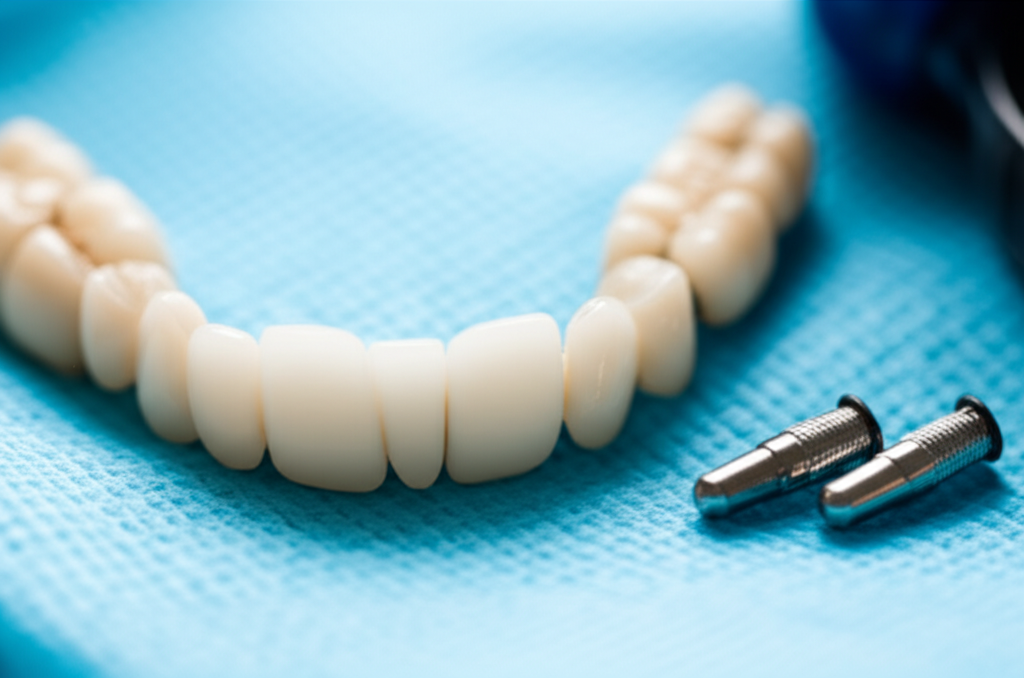
The Complete Dental Implant Process: A Step-by-Step Guide
Thinking about getting dental implants? This friendly, easy-to-follow guide shows you what happens during the whole journey—from your first visit to your final smile. We’ll answer your questions and help you feel ready for every step. If you wonder how long it takes, how much it costs, or what you’ll feel after, this article is for you!
Table of Contents
What Are Dental Implants and Why Do People Need Them?
Dental implants are things that take the place of missing teeth. They are kind of like a screw or anchor (usually made from titanium or zirconia) that your dentist puts into your jawbone. Later, a fake tooth (crown) goes on top. People get dental implants when they lose a tooth from a cavity, gum problems, or an accident. Dental implants work a lot like real teeth. You can eat, talk, and smile just like normal.
Why are dental implants so important?
If you have missing teeth, it can be hard to eat or talk. When teeth are gone, the jawbone can shrink, which sometimes makes your face look different. Dental implants help with both of these problems. They look real and help keep your jawbone strong. If you want a fix that lasts a long time, implants are a good way to go.
Why Should You Learn About the Dental Implant Process?
Getting dental implants is a big choice. You might have a lot of questions and even feel nervous—and that’s okay! When you understand what will happen, you’ll feel calmer and more ready.
Here’s why it helps to learn about dental implants:
- You’ll know what to expect, like how long it takes (usually 4-9 months).
- You won’t be so worried about going to the dentist.
- You can plan for healing time and days off if you need them.
- You’ll know how to take care of your new teeth now and later.
If you want teeth that look real and last a long time, dental implants from a reliable clinic or a trusted implant dental laboratory are a smart pick.
What Happens at the First Dental Implant Appointment?
You start with a dental implant checkup. The dentist (it might be an oral surgeon, periodontist, or prosthodontist) asks about your teeth, your health, and any problems like diabetes or bone problems that can make healing take longer.
Here’s what you do at your first visit:
The dentist looks at your teeth and gums. They make sure you don’t have gum disease or tooth decay. Your gums need to be healthy for implants to work.
Pictures and scans let the dentist see your jawbone. They check if there’s enough bone to hold an implant and look out for nerves and sinuses.
If you want to go ahead, the dentist might make a copy of your teeth to help your new tooth look and fit like your old ones.
You’ll talk about:
- How many teeth you need to fix
- Prices and insurance
- Ways to stay comfortable (numbing the mouth or sleeping medicine)
- How long the plan might take, depending on your health and jawbone
Do You Need Preparatory Steps Like Tooth Extraction or Bone Grafting?
Some people have to do extra steps before getting an implant.
Tooth Removal
If there’s a tooth that’s broken or rotten, the dentist will take it out. Sometimes you get the implant the same day, but often your gums need a few weeks to heal first.
Bone Grafting
If your jawbone isn’t thick or strong enough, the dentist can do a bone graft. That means adding more bone—maybe from your own body, a donor, an animal, or a made-up material—to your jaw. You might need to wait 3–6 months for the new bone to mix in and get strong.
Sinus Lift
If your upper jaw isn’t tall enough, or your sinuses are close, a sinus lift can help. This lifts up the sinus and adds more bone under it.
These steps are important! They help your implant last a long time. Your dentist will make sure you’re comfortable during these treatments.
How Do Dentists Place the Dental Implant?
Here’s how dental implant surgery usually goes:
You’ll get medicine to make sure you don’t feel pain. That might just numb your mouth or help you sleep (for big jobs).
The dentist makes a little cut in your gums to reach your jawbone.
Special tools make a small space in the bone, being careful to stay away from nerves and blood vessels.
The titanium or zirconia screw (the implant) goes into the spot in the bone.
The dentist might sew your gum shut over the implant, or put on a healing cap.
After this step, you go home and let your mouth heal. Most people feel a little sore or puffy for a few days, but medicine helps with that.
Table: Dental Implant Placement in Simple Steps
| Step | What Happens | How Long? |
|---|---|---|
| Numbing | Makes you comfortable | Minutes |
| Gum Cut | Gum is opened | Few minutes |
| Drilling | Small hole made in bone | 5-10 minutes |
| Implant Insertion | Screw put into place | 5-15 minutes |
| Stitches/Healing cap | Gums closed or cap put on | Minutes |
| Whole process | For most: under 1 hour | 30-60 minutes |
What Is Osseointegration and Why Is It So Important?
After the implant goes in, something called osseointegration happens. This just means your bone grows around the implant and holds it tight. That’s why implants feel just like real teeth.
How Long Does Healing Take?
- Osseointegration takes 3–6 months for most people.
- The implant gets as strong as your own tooth root.
- While you’re healing, you can wear a fake tooth to keep your smile looking good.
Don’t rush this part! Your jawbone needs time to hold onto the implant.
How Is the Abutment Placed on the Implant?
Almost done! Once the bone and implant are stuck together well, it’s time for the abutment. That’s the small piece that connects the implant and the crown (your fake tooth).
What Happens?
Your gums may take 1–2 weeks to heal and settle around the abutment. This helps your tooth look natural.
How Does the Dentist Add the Final Crown or Tooth?
Here comes the fun part: getting your new tooth!
Steps:
Your dentist takes molds or digital pictures so the crown fits just right.
A dental laboratory, like a dental ceramics lab or crown and bridge lab, makes your fake tooth to match your other teeth.
The dentist makes sure your new tooth feels good in your mouth, then puts it on the abutment.
Time to show your new smile to the world!
How Do You Take Care of Your Dental Implants?
Dental implants are strong, but you need to look after them. Like real teeth, good cleaning and checkups are important.
Easy Tips:
- Brush two times a day with a soft brush.
- Floss gently, especially around the implant.
- Use special brushes if your dentist gives them to you.
- Don’t bite hard things like ice or hard candy.
- See your dentist every six months for a cleaning.
If you keep your mouth clean, implants can last for life! Sometimes, you’ll need to replace the crown (the fake tooth) in 10–15 years, but the screw in your bone usually stays good forever.
If you want more tips, ask your dentist or see if they work with a digital dental lab or a zirconia lab for the strongest new teeth.
What Are the Benefits and Risks of Dental Implants?
Benefits
- Look and Feel Real: They fit right in with your own teeth.
- You Can Chew Anything: Just like normal teeth.
- Stops Bone Loss: Keeps your jaw healthy.
- Can Last Your Whole Life: With good care, they rarely fail.
- Comfortable: No slipping like dentures.
Risks and Problems
There are a few risks, but they usually aren’t bad:
- Infection where the implant is
- Swelling or bruising
- Nerve damage (rare)
- Sinus trouble with top implants
- Implant doesn’t work (very rare, usually from not cleaning or bad health)
Most problems can be avoided with a good dentist and checkups.
Table: Dental Implant Fast Facts
| Aspect | Usual Details |
|---|---|
| Success Rate | 95–98% after 10 years |
| Healing Time | 3–6 months |
| Life of Implant (Screw) | 20+ years, sometimes for life |
| Crown Change Time | Every 10–15 years |
| Happy Patients | Over 90% |
| Chewing Power | 90–100% of normal teeth |
| Cost (One Implant) | $3,000–6,000 |
| Chance of Complications | 5–10% (most are small issues) |
Your Most Common Dental Implant Questions—Answered!
Q: Does dental implant surgery hurt?
A: Most people say it feels like having a tooth pulled. The dentist will numb your mouth, so you shouldn’t feel pain. Some soreness after is normal and goes away with medicine.
Q: How long does it take?
A: Usually 4–9 months from start to end. It’s faster if you don’t need extra steps.
Q: Will my implants look fake?
A: No! Labs make the crown to match your other teeth, so most people can’t tell.
Q: What can I eat after getting implants?
A: Soft foods for a few days. After healing, you can eat almost anything.
Q: Can everyone get dental implants?
A: Most grown-ups can, if they have healthy gums and enough bone. Smokers or people with health problems might need extra checkups.
Key Points to Remember
- Dental implants are a long-lasting way to fix missing teeth and feel like real ones.
- The steps are simple: checkup, planning, maybe bone add or tooth out, surgery, healing, putting on the connector, placing the tooth, and good cleaning afterward.
- Healing time is not the same for everyone. Most people need 4–9 months start to finish.
- Brush, floss, and see your dentist for best results.
- Implants have a high success rate (95–98%) and almost everyone likes them.
- Risk is low, especially if you visit your dentist often.
- Using skilled labs, like a china dental lab or a removable denture lab, gives you top results and feels best.
You can smile confidently! With good care and the right dental team, implants can keep your mouth and smile happy for life.
References
(Want more advice? Check out our other articles about dental problems or talk to your dental team!)








